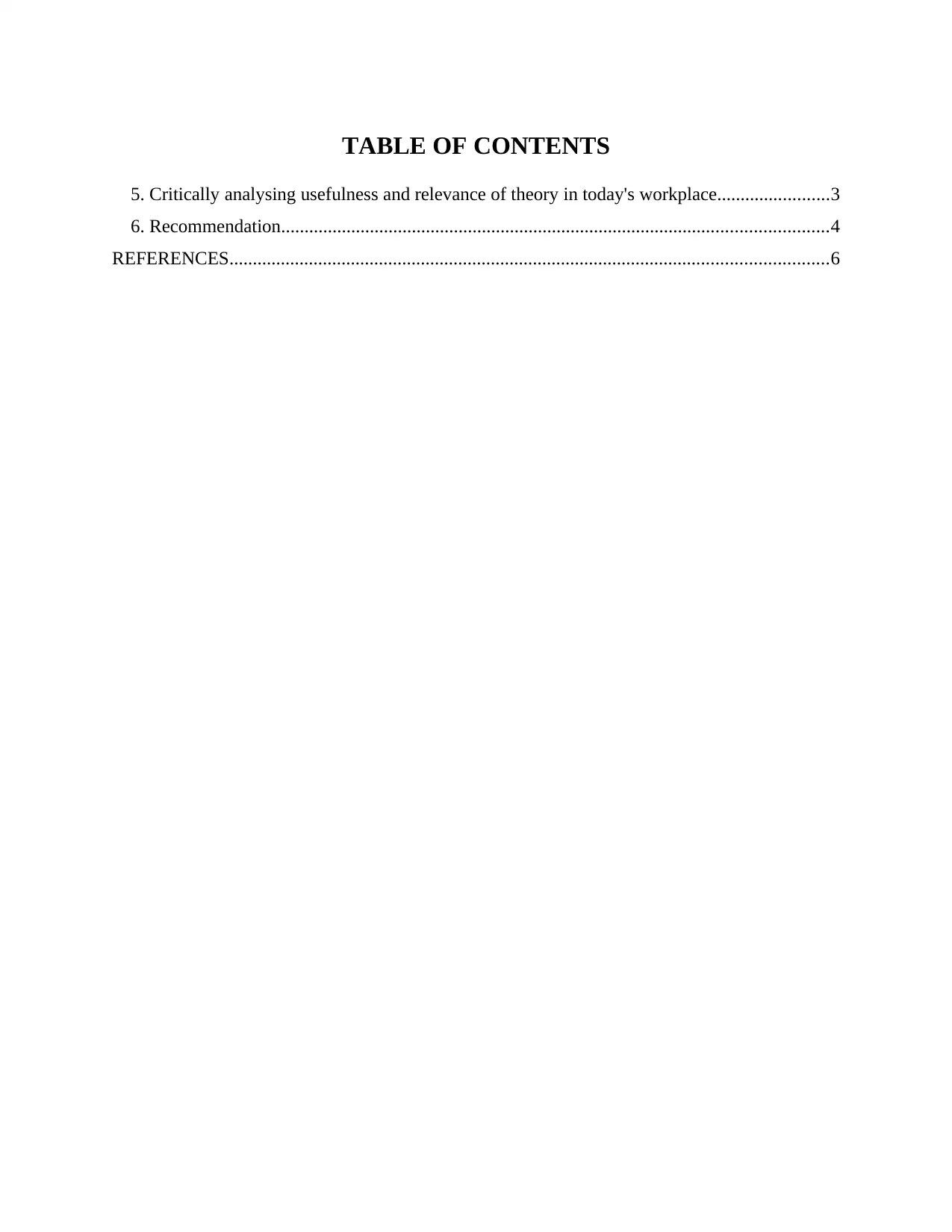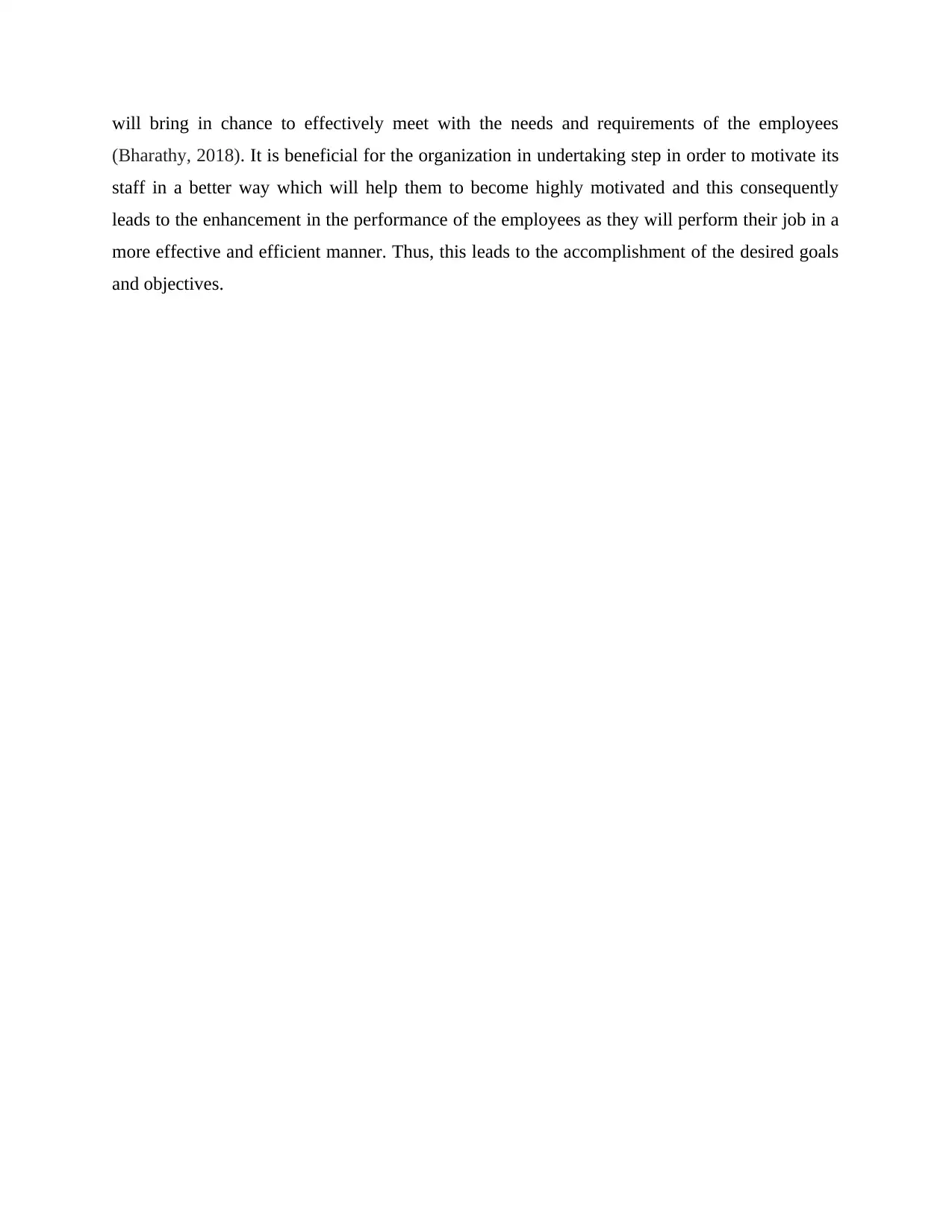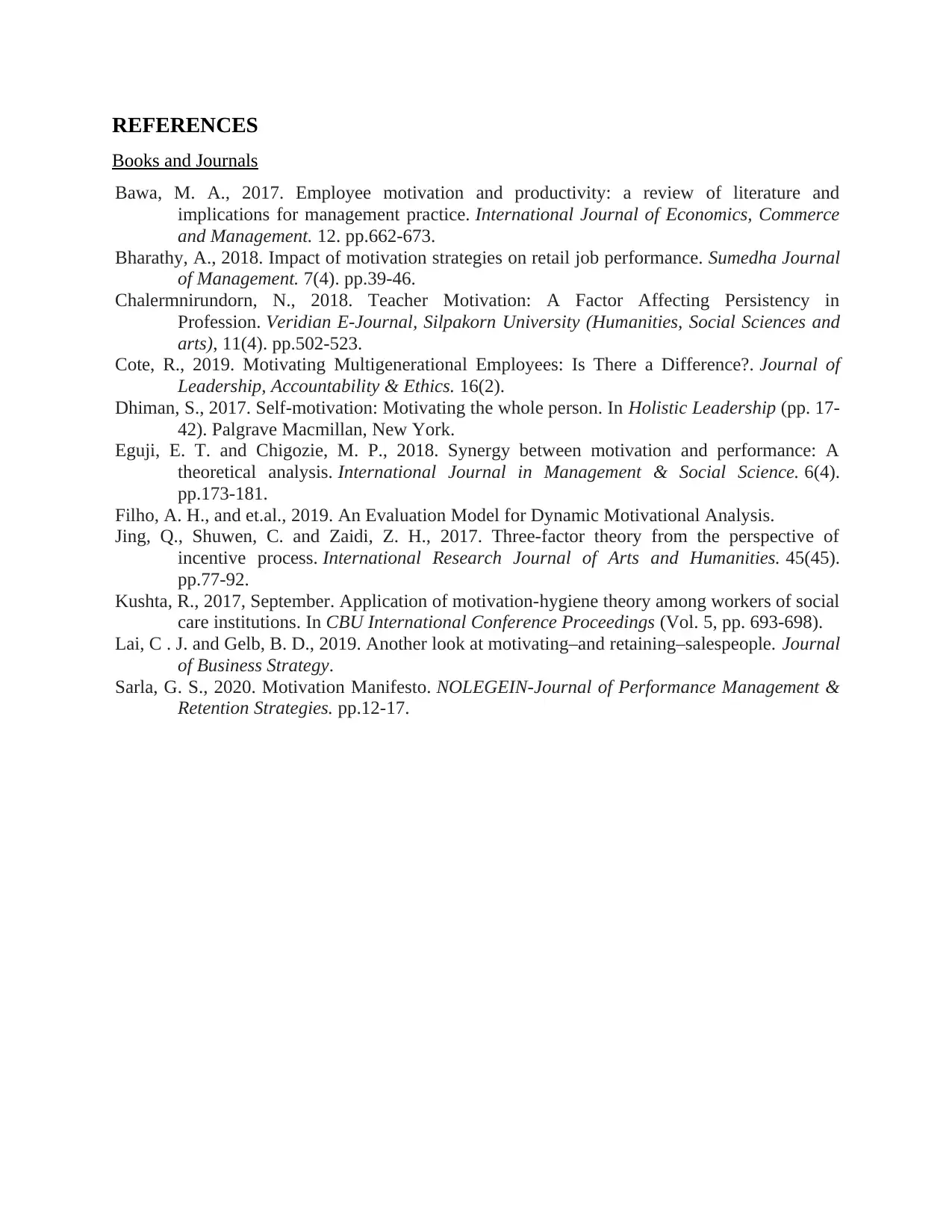Critically Analyzing Management Theory in Today's Workplace: A Report
VerifiedAdded on 2022/12/23
|7
|1464
|98
Report
AI Summary
This report critically analyzes the usefulness and relevance of management theory in today's workplace, focusing on Herzberg's Two-Factor Theory. It explores the application of the theory in real-world organizations, such as Tesco, highlighting strategies for motivating employees through hygiene factors and motivators. The report discusses techniques like job enrichment and enlargement, while also acknowledging the limitations of the theory, such as its applicability primarily to white-collar environments and potential biases. Recommendations are provided for effectively analyzing hygiene factors and implementing strategies to improve employee performance and career progression. The future usefulness of the theory is also considered, emphasizing its potential to meet employee needs and enhance overall organizational goals.

Management theory
Paraphrase This Document
Need a fresh take? Get an instant paraphrase of this document with our AI Paraphraser

TABLE OF CONTENTS
5. Critically analysing usefulness and relevance of theory in today's workplace........................3
6. Recommendation.....................................................................................................................4
REFERENCES................................................................................................................................6
5. Critically analysing usefulness and relevance of theory in today's workplace........................3
6. Recommendation.....................................................................................................................4
REFERENCES................................................................................................................................6

5. Critically analysing usefulness and relevance of theory in today's workplace
The Two Factor Theory can be applied to the real world organization which will help the
management in effective motivating its employees. This will result into achieving the desired
level of efficiency. It can be implemented in the steps- first by eliminating the job hygiene
stressors and the second is boosting the job satisfaction. Under the first step, the management is
required to make sure that the hygiene factors are not creating any sort of dissatisfaction. Every
person will examine the hygiene factor in a unique way which will differ from one person to
another (Dhiman, 2017). This makes it crucial for the management in ensuring that all the
relevant factors are considered and taken care of. This can be possible through the way of
implementing supportive work culture by introducing the democratic leadership style and
making changes to the policies of the organization. The second step is to enhancing the job
satisfaction level of the employees. This can be done by improvising the actual content of the job
and in this again a unique approach is required to be implemented. In order to achieve this, there
are 3 techniques which is being utilized by the organizations in the real world. The first
technique is job enrichment which refers to enriching the group member's job through the way of
putting more challenges and complex task to perform (Chalermnirundorn, 2018). This results
into making the task more interesting. The next technique is job enlargement which accounts for
involving the team member in the variety of task and this also results in making the job much
more interesting but under this, the task is increased but the level of difficulty remains the same.
The last technique is through empowering employees with more responsibilities towards the
other team members which makes them feel responsible and accountable for the task of others.
For example, the real like organization like Tesco has also motivated its employees by
using Herzberg model of motivation. The organization aims to motivate its employees through
the way of paying more attention towards the hygiene factors along with enabling the satisfiers
(Jing, Shuwen and Zaidi, 2017). Tesco motivates its employees in terms of providing them
proper and timely communication in addition to the delegation of the responsibility. It also
involves its employees in the relevant decision-making process and apart from this, the
organization also holds the forum each year, where employees are involved in making discussion
regarding their pay rise. This highlights the recognition of the work of the people of Tesco and
rewards them (Filho and et.al., 2019). The employees of Tesco can even provide their opinion on
the food menu which goes into its restaurants. In this way, employees are motivated.
The Two Factor Theory can be applied to the real world organization which will help the
management in effective motivating its employees. This will result into achieving the desired
level of efficiency. It can be implemented in the steps- first by eliminating the job hygiene
stressors and the second is boosting the job satisfaction. Under the first step, the management is
required to make sure that the hygiene factors are not creating any sort of dissatisfaction. Every
person will examine the hygiene factor in a unique way which will differ from one person to
another (Dhiman, 2017). This makes it crucial for the management in ensuring that all the
relevant factors are considered and taken care of. This can be possible through the way of
implementing supportive work culture by introducing the democratic leadership style and
making changes to the policies of the organization. The second step is to enhancing the job
satisfaction level of the employees. This can be done by improvising the actual content of the job
and in this again a unique approach is required to be implemented. In order to achieve this, there
are 3 techniques which is being utilized by the organizations in the real world. The first
technique is job enrichment which refers to enriching the group member's job through the way of
putting more challenges and complex task to perform (Chalermnirundorn, 2018). This results
into making the task more interesting. The next technique is job enlargement which accounts for
involving the team member in the variety of task and this also results in making the job much
more interesting but under this, the task is increased but the level of difficulty remains the same.
The last technique is through empowering employees with more responsibilities towards the
other team members which makes them feel responsible and accountable for the task of others.
For example, the real like organization like Tesco has also motivated its employees by
using Herzberg model of motivation. The organization aims to motivate its employees through
the way of paying more attention towards the hygiene factors along with enabling the satisfiers
(Jing, Shuwen and Zaidi, 2017). Tesco motivates its employees in terms of providing them
proper and timely communication in addition to the delegation of the responsibility. It also
involves its employees in the relevant decision-making process and apart from this, the
organization also holds the forum each year, where employees are involved in making discussion
regarding their pay rise. This highlights the recognition of the work of the people of Tesco and
rewards them (Filho and et.al., 2019). The employees of Tesco can even provide their opinion on
the food menu which goes into its restaurants. In this way, employees are motivated.
⊘ This is a preview!⊘
Do you want full access?
Subscribe today to unlock all pages.

Trusted by 1+ million students worldwide

But in contrast to the above, there are some negatives aspects of this model as well,
which is needed to be accounted for. This theory is mainly applicable to the white collar business
entities. It sometimes fails to take into account individual's situation or the perception into view
(Eguji and Chigozie, 2018). This theory of motivation is mainly concentrated towards improving
the satisfaction level of the employees but it does not necessarily mean that the increase in the
employee satisfaction will lead to enhancement in the performance and productivity (Cote,
2019). Therefore, there is no clear and objective way of measuring and monitoring the employee
satisfaction in the theory. In addition to this, the two factor theory is also subject to bias as under
the situation when the employees are satisfied they give credit to themselves for that while in the
opposite situation, that is, when they are less satisfied or dissatisfied, then they would blame the
external factors. Therefore, this Herzberg’s Motivation Theory is useful and applicable to real
like organization but it is important for the management to understand the limitations of this
theory in order to effective make use of it in respect to motivating the employees and improving
their performance.
6. Recommendation
It can be stated that the Herzberg’s Motivation Theory is based on the two factors which
are hygiene factors and the other is satisfiers (Lai and Gelb, 2019). It is important to have all the
hygiene factor within the organization, otherwise, it might result into creating dissatisfaction
because of inadequacy of it. It can be improved through the way of making changes in the
hygiene factors which will result into motivating the employees (Kushta, 2017). But apart from
the benefits it brings in, there are certain cons which are to be accounted for. Therefore, it is
highly recommended to the organization to effective analyse the hygiene factors which can have
an impact over the performance of the employees. These factors will differ from person to person
but the management look for the common factors which affect the need of the employees (Sarla,
2020). The organization by the way of providing better and valuable opportunities to its
managers and staff in respect to the taking a share or interest within the job or employment.
Through the way of implementing the process of reviews and personal development plan
which will allow the entity in effectively and efficiently recognizing the abilities and the
accomplishments of the employees along with potential development of the same (Bawa, 2017).
By the way of implementing these strategies will help in offering the career progression. In terms
of future usefulness of this theory, it can be said that it will be great importance in the future as it
which is needed to be accounted for. This theory is mainly applicable to the white collar business
entities. It sometimes fails to take into account individual's situation or the perception into view
(Eguji and Chigozie, 2018). This theory of motivation is mainly concentrated towards improving
the satisfaction level of the employees but it does not necessarily mean that the increase in the
employee satisfaction will lead to enhancement in the performance and productivity (Cote,
2019). Therefore, there is no clear and objective way of measuring and monitoring the employee
satisfaction in the theory. In addition to this, the two factor theory is also subject to bias as under
the situation when the employees are satisfied they give credit to themselves for that while in the
opposite situation, that is, when they are less satisfied or dissatisfied, then they would blame the
external factors. Therefore, this Herzberg’s Motivation Theory is useful and applicable to real
like organization but it is important for the management to understand the limitations of this
theory in order to effective make use of it in respect to motivating the employees and improving
their performance.
6. Recommendation
It can be stated that the Herzberg’s Motivation Theory is based on the two factors which
are hygiene factors and the other is satisfiers (Lai and Gelb, 2019). It is important to have all the
hygiene factor within the organization, otherwise, it might result into creating dissatisfaction
because of inadequacy of it. It can be improved through the way of making changes in the
hygiene factors which will result into motivating the employees (Kushta, 2017). But apart from
the benefits it brings in, there are certain cons which are to be accounted for. Therefore, it is
highly recommended to the organization to effective analyse the hygiene factors which can have
an impact over the performance of the employees. These factors will differ from person to person
but the management look for the common factors which affect the need of the employees (Sarla,
2020). The organization by the way of providing better and valuable opportunities to its
managers and staff in respect to the taking a share or interest within the job or employment.
Through the way of implementing the process of reviews and personal development plan
which will allow the entity in effectively and efficiently recognizing the abilities and the
accomplishments of the employees along with potential development of the same (Bawa, 2017).
By the way of implementing these strategies will help in offering the career progression. In terms
of future usefulness of this theory, it can be said that it will be great importance in the future as it
Paraphrase This Document
Need a fresh take? Get an instant paraphrase of this document with our AI Paraphraser

will bring in chance to effectively meet with the needs and requirements of the employees
(Bharathy, 2018). It is beneficial for the organization in undertaking step in order to motivate its
staff in a better way which will help them to become highly motivated and this consequently
leads to the enhancement in the performance of the employees as they will perform their job in a
more effective and efficient manner. Thus, this leads to the accomplishment of the desired goals
and objectives.
(Bharathy, 2018). It is beneficial for the organization in undertaking step in order to motivate its
staff in a better way which will help them to become highly motivated and this consequently
leads to the enhancement in the performance of the employees as they will perform their job in a
more effective and efficient manner. Thus, this leads to the accomplishment of the desired goals
and objectives.

REFERENCES
Books and Journals
Bawa, M. A., 2017. Employee motivation and productivity: a review of literature and
implications for management practice. International Journal of Economics, Commerce
and Management. 12. pp.662-673.
Bharathy, A., 2018. Impact of motivation strategies on retail job performance. Sumedha Journal
of Management. 7(4). pp.39-46.
Chalermnirundorn, N., 2018. Teacher Motivation: A Factor Affecting Persistency in
Profession. Veridian E-Journal, Silpakorn University (Humanities, Social Sciences and
arts), 11(4). pp.502-523.
Cote, R., 2019. Motivating Multigenerational Employees: Is There a Difference?. Journal of
Leadership, Accountability & Ethics. 16(2).
Dhiman, S., 2017. Self-motivation: Motivating the whole person. In Holistic Leadership (pp. 17-
42). Palgrave Macmillan, New York.
Eguji, E. T. and Chigozie, M. P., 2018. Synergy between motivation and performance: A
theoretical analysis. International Journal in Management & Social Science. 6(4).
pp.173-181.
Filho, A. H., and et.al., 2019. An Evaluation Model for Dynamic Motivational Analysis.
Jing, Q., Shuwen, C. and Zaidi, Z. H., 2017. Three-factor theory from the perspective of
incentive process. International Research Journal of Arts and Humanities. 45(45).
pp.77-92.
Kushta, R., 2017, September. Application of motivation-hygiene theory among workers of social
care institutions. In CBU International Conference Proceedings (Vol. 5, pp. 693-698).
Lai, C . J. and Gelb, B. D., 2019. Another look at motivating–and retaining–salespeople. Journal
of Business Strategy.
Sarla, G. S., 2020. Motivation Manifesto. NOLEGEIN-Journal of Performance Management &
Retention Strategies. pp.12-17.
Books and Journals
Bawa, M. A., 2017. Employee motivation and productivity: a review of literature and
implications for management practice. International Journal of Economics, Commerce
and Management. 12. pp.662-673.
Bharathy, A., 2018. Impact of motivation strategies on retail job performance. Sumedha Journal
of Management. 7(4). pp.39-46.
Chalermnirundorn, N., 2018. Teacher Motivation: A Factor Affecting Persistency in
Profession. Veridian E-Journal, Silpakorn University (Humanities, Social Sciences and
arts), 11(4). pp.502-523.
Cote, R., 2019. Motivating Multigenerational Employees: Is There a Difference?. Journal of
Leadership, Accountability & Ethics. 16(2).
Dhiman, S., 2017. Self-motivation: Motivating the whole person. In Holistic Leadership (pp. 17-
42). Palgrave Macmillan, New York.
Eguji, E. T. and Chigozie, M. P., 2018. Synergy between motivation and performance: A
theoretical analysis. International Journal in Management & Social Science. 6(4).
pp.173-181.
Filho, A. H., and et.al., 2019. An Evaluation Model for Dynamic Motivational Analysis.
Jing, Q., Shuwen, C. and Zaidi, Z. H., 2017. Three-factor theory from the perspective of
incentive process. International Research Journal of Arts and Humanities. 45(45).
pp.77-92.
Kushta, R., 2017, September. Application of motivation-hygiene theory among workers of social
care institutions. In CBU International Conference Proceedings (Vol. 5, pp. 693-698).
Lai, C . J. and Gelb, B. D., 2019. Another look at motivating–and retaining–salespeople. Journal
of Business Strategy.
Sarla, G. S., 2020. Motivation Manifesto. NOLEGEIN-Journal of Performance Management &
Retention Strategies. pp.12-17.
⊘ This is a preview!⊘
Do you want full access?
Subscribe today to unlock all pages.

Trusted by 1+ million students worldwide

1 out of 7
Related Documents
Your All-in-One AI-Powered Toolkit for Academic Success.
+13062052269
info@desklib.com
Available 24*7 on WhatsApp / Email
![[object Object]](/_next/static/media/star-bottom.7253800d.svg)
Unlock your academic potential
Copyright © 2020–2025 A2Z Services. All Rights Reserved. Developed and managed by ZUCOL.




